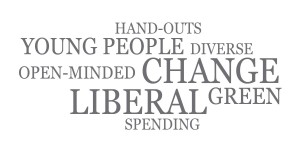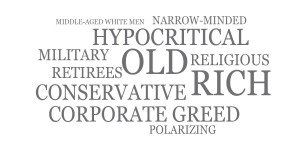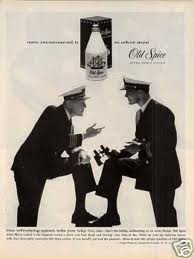Last year, The New York Times Magazine reported on a survey of swing voters that asked a very interesting question: what do you associate with the words Democrat and Republican? This is a branding 101 question, designed to elicit top-of-mind values for the respective party brands. The results are seen (respectively) in the images below, which are Wordles—word clouds that reflect greater prominence to words that appear more frequently in the responses.


The Democratic brand fares pretty well, although there is a nod to the idea that they are a party that supports the “takers.” However, if one were in charge of the Republican brand, one might seriously consider a rebranding initiative. And quickly! I post this not to argue a political stance, but rather to illustrate when circumstances point to a serious need to re-examine the foundational values of one’s brand.
Branding is the ownership of ideas: take an idea or value that customers esteem, and then impart that idea/value into the brand so that customers see a shining reflection of themselves. Branding serves as a mirror of self. It is a way for customers to accessorize their identity by associating with various brands that evoke how they, the customers, desire to be perceived. But what if intent and actuality were on two different planes? That is, what if customers see a set of values that are different than the ones the brand intends: and more importantly, values to which they don’t relate? Common wisdom suggests exploring a rebranding.
Rebranding doesn’t necessarily mean a complete identity change where the original brand enters the witness protection program, and a new identity—name and all—is needed. This can sometimes be the case. More often, the name remains and the brand gets a make-over to better secure the values it seeks to instill in customers’ minds. So when is it appropriate to rebrand? When your brand’s current value to customers is dramatically different than your current identity.
How does a brand know when it is time to change? Brand equity research is essential before changing anything. Qualitative—and even quantitative—measures are available to assess what values (good and bad) are parts of the brand. Insights gained from such research can point to elements that need to change, as well as need to remain. I’m not just talking about the visual assets—the logo, color, iconography etc. Rather, also how the brand behaves. As I’ve said in previous posts, a logo is a flag that allows customers to immediately call up a series of values in their minds. Those values are established in how the brand acts, not just in how the brand appears. Let’s examine three different scenarios where rebranding is a wise choice.
The Good: The current identity does not capture how much the brand has changed in customers’ minds. Perhaps your brand has outgrown its identity. It is an enviable “problem” to have, but still requires a rebranding to leverage the new ways customers esteem your brand or else you could lose momentum. Consider the brand youSENDit. It was launched in 2004 as a service that pretty much did what it’s name indicated: send large files over the internet. youSENDit was very successful, with over 43 million customers to date. However, over the last ten years, the brand has developed many new services beyond just sending files. Cloud storage, intra-cloud exchanges and real-time portals for ideas and information have transformed the brand in customers’ minds beyond its original intention.


youSENDit rebranded in 2013 with a complete identity change to Hightail. The name was holding it back. (Some might remember the brand Record World, which died a rather abrupt death as CDs became the dominant format, and another company bought the rights to CD World. Uh-oh.) Hightail evokes the idea of “going as fast as you can,” and implies that customers gain a personal ability to keep pace with rapid change. The shift from green/blue (reassuring) to red (energy, passion, action) makes a bold statement that announces a new brand behavior.
The Bad: Associations with the current identity are irrelevant or non-existent to customers. Brands can seem so important and essential in one situation, and completely the opposite as times change. Many of you may be too young to remember that Old Spice was a fragrance brand that was born in 1938, and used the image of sailors—who were rugged, “salty” men, with a mystique of adventure and worldwide savvy. There were buoy-shaped bottles, and an icon of a schooner.


By the 1970s and 80s, the brand became known as your Dad’s aftershave, and its equity declined among new generations. Proctor & Gamble re-launched the brand, capitalizing on a new set of values that customers were seeking. Young men want to learn about grooming, but are often intimidated by the subject. Their girlfriends find themselves as default mentors, urging their men to adopt more sophisticated habits, but without seeming pushy.


Enter the new Old Spice, with a vibrant brand image of approachable charm (“Believe in your smellf”), and an attractive, mockingly self-confident spokesperson who appeals to women: “Your man is not me, but he can smell like me.” P&G kept the name and the nautical theme, but updated the brand in a way in which young customers (and their girlfriends) could see a flattering reflection of themselves. (The Republican Brand could take a serious lesson here.)
The Ugly: Associations with the current identity are so bad that recovery
is unlikely. Pity the poor brand that the very mention of its name is a punch line. If the product is bad, then nothing anyone can do can revive it. However, if the product has merit, then a re-branding can help it find new life in the market. Consider the plight of Xenical (orlistat), a prescription drug launched in the late 90s by Roche. The FDA cleared the way for Rx brands to run promotion on TV in 1996, and it created a frenzy among healthcare companies to test the waters of this powerful medium. You may remember the Xenical commercials, but not for what the brand claimed to do: help people lose weight. The full disclosure mandated by the FDA compels Rx brands to promote a “fair balance” of side effects, and Xenical became the poster-brand for late night comedy show parodies. Oily, loose stools with excessive flatulence, unexpected fecal incontinence and frequent or urgent bowel movements were what customers remembered most.


The brand re-emerged in 2007 as alli, an over-the-counter weight loss treatment from Glaxo Smith Kline. GSK took a more conservative approach that managed expectations and reduced the dose for a less traumatic experience. The brand found its audience, but it required complete plastic surgery to pull it off credibly. (Still, old impressions die hard. Dialogue on the Internet is punctuated by the occasional: “She had an alli-oops.”)
Rebranding does not solve every problem a brand might have with its image. In fact, it should be considered as a last resort. Use brand equity research with customers as your beacon, and if you find—as the Republicans did—that central associations with your brand are “narrow-minded,” “hypocritical” and “greed,” you might want to pick up the phone and call a branding expert. Immediately.

Hello guys, I am Yasser Kouma a professional in report writing.
I enjoy solving people’s problems and make them happy. That is what I have been doing for many years now.
I have been writing since I was 12 years old and never knew it would turn out to be a full-time career. I have also been able to handle several assignments that involves writing. And I worked in three organizations as a volunteer to assist people.My passion has always been to help people succeed. And I go the extra mile to make that happen.
I enjoy writing academic papers and have helped people from countries like USA.
I work with a company whose mission is to provide quality writing and make people happy. In fact, many people come to me for professional help on a daily basis because they know I always deliver. And I will continue to provide nothing but the best to build trust like I have been doing for the past few years.
Expert writer – Yasser Kouma – myworthwhilebooks.com Confederation